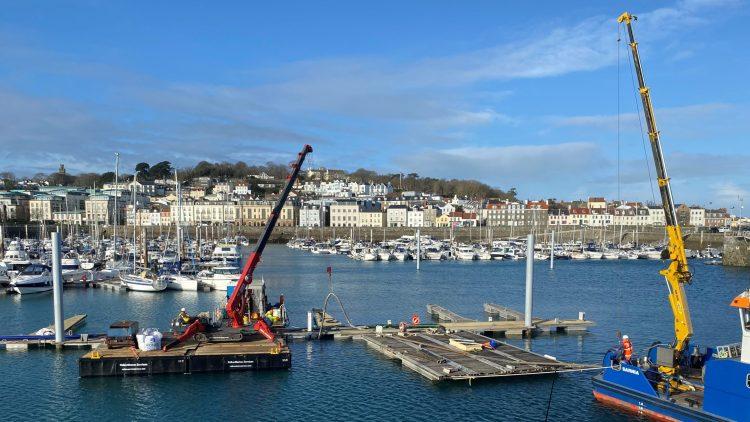Significant upgrades to the QEII Marina are taking shape, with new pontoons shipped into the island and the construction of new concrete supporting structures.
The £1.4m investment in marina facilities will replace and upgrade two pontoons in the QEII Marina which date back to the 1980s. It is part of a multi-million programme of investment that is required in the QEII this decade.
The new pontoons have been shipped into the island in trailers in recent days and are being stored at the work compound which has been set up at the East Arm for the duration of the project.
Around 120 boats previously moored to pontoons D&E have now moved temporarily to alternative berths, or have been craned out of the water to sit in dry dock at the East Arm or Castle Emplacement.
The size and weight of the new galvanised steel pontoons requires the construction of three underwater concrete bases for new supporting piles. Guernsey Ports’ dive team and engineers are currently working with contractors to construct and fit the piles.
Meanwhile, assembly of the new concrete flotation blocks, pontoon walkways, finger pontoons and other fittings is beginning on the other side of the East Arm worksite. As they are constructed, the new pontoons will be craned into the water and floated in stages.
Guernsey Ports project civil engineer Jenny Giles said: “Our Ports teams are working closely with contractors both on land and underwater on these complex and major works. The reinforcement of the original piles and construction of three new supporting pile structures will ensure strong foundations for the new pontoons.”
Moorings for larger leisure craft are in strong demand and the new pontoons have been purpose-built for vessels of this type.
Assistant harbourmaster Kieran Higgs said: “The replacement of the old pontoons has provided us with the opportunity to reconfigure the berths to make better use of the space available.
“The area closest to the East Arm has the deepest water of any of our marinas, which makes it ideal for larger vessels, and particularly sailing vessels with deeper drafts. This will help us satisfy some demand for larger berths that are currently in very short supply.”
The project commenced in mid-January and is expected to take around three months to complete.














